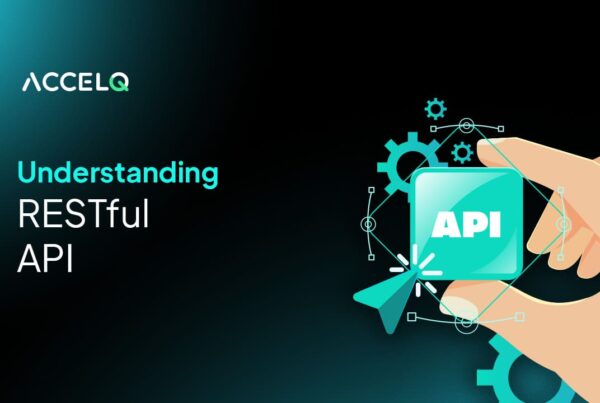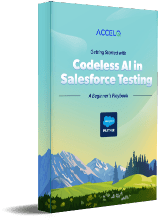
Just like the ‘behind every successful man stands a woman’ adage, in the business environment, it can safely be said that behind every successful Salesforce implementation stands Salesforce test automation.
Salesforce is a technology that powers many organizations and needs no introduction. Salesforce applications have been helping organizations to drive customer experience with deeper insights and real-time, detailed information into all the variables influencing sales and operations. The Salesforce CRM promises a revenue increase of almost 37% post-implementation.
As a top-tier, highly customizable, and extensible CRM, Salesforce is designed to meet the growing needs of today’s enterprise. It capably unites disparate departments such as marketing, sales, service, IT, operations, and commerce and provides one integrated platform to power a suite of connected applications.
However, to reap the power of Salesforce, Salesforce test automation becomes a critical capability to develop.
Why automate Salesforce applications?
Let’s understand the Salesforce ecosystem –
- Salesforce is highly customizable to meet enterprise needs.
- It can be easily integrated with other enterprise applications.
- It releases a multitude of features, functionalities, and updates at least thrice a year to meet the customer and market demands.
Implementing Salesforce, its updates, and customizing applications demand a thorough focus on testing to ensure that none of these changes impact or break the existing functionality.
Functional testing also becomes critical in customizations to validate the customized Salesforce functionality and ensure that it does not cause any breaks in the system. Manual testing is not a viable option because,
- It can take up a lot of time and effort owing to the complexities at work.
- Manual testing slows down the delivery cycles.
- It also limits testing quality given the complexities of Salesforce applications.
- Improving test coverage and increasing the speed and efficiency of testing is essential for cloud-based applications like Salesforce that have periodic releases, and manual testing cannot keep pace with this.
Automating Salesforce testing increases testing coverage and makes it easier to test hundreds of scenarios in a few hours. Reduced costs, improved speed, and efficiency become the natural consequences of these efforts.
Given that Salesforce is a critical tool for enterprises, testing Salesforce applications fast and extensively is even more imperative. Additionally, any break or downtime in the application can have a business impact, making it essential to automate Salesforce application testing.
How to perform Salesforce test automation?
To automate Salesforce application testing, organizations can use one of the two approaches – the code-based frameworks or the no-code automation path.
Open-source tools such as Selenium are common choices for code-based frameworks for Salesforce test automation. However, the setup time for these frameworks is higher since they need coding. You also need strong programming skills to set up, test and maintain these frameworks.
No-code test automation platforms are the other option to accelerate the pace of Salesforce test automation. No-code tools that use a visual language remove dependencies such as programming knowledge, test setup, and maintenance. Organizations can leverage a cloud-hosted continuous test automation and management platform that employs advanced AI-driven automation optimized for Salesforce-specific technology. This helps organizations accelerate the testing velocity test fast and test often.
Irrespective of the approach you choose, the test automation platform should also:
- Ensure end to end validation for test automation
- Enable cloud-based execution with cross-browser and OS for complete validations
- Provide integration with ALM tools for requirements and defect integrations
- Capably automate executions orchestrated by CI workflow
- Enable in-sprint automation using Intelligent abstraction for Salesforce workflows
Salesforce Test Automation in Shifting Landscape
A Beginners’ Guide
Why are Salesforce applications difficult to automate?
Applications built on Salesforce can be pretty complex because of several reasons, such as
- They contain many dynamic elements that do not have fixed IDs, names, classes of CSS attributes.
- Identifying UI elements in test automation becomes difficult as Salesforce uses Shadow DOMs to isolate components.
- Frequent system updates from Salesforce also add to automation complexity since any change can impact user customizations.
- In some cases, it can also impact the standard use of the platform.
- QA teams, as such, have a heavy maintenance focus, especially when using a code-based automation framework, as any change means adding changes to the code as well.
- Different database-driven tables in Salesforce add to automation complication, especially with code-based frameworks since simple actions like ticking a checkbox in dynamically created and controlled rows can prove immensely challenging.
- Automation tools also need to identify the new tabs since, in Salesforce, a new tab is a new frame. The automation tool needs to identify the elements under frame. Scripting the logic in code-based frameworks becomes challenging and needs extremely experienced testers.
- Identifying visual elements in Salesforce is complicated since these are hidden for development purposes, thereby making Salesforce applications challenging to automate.
Best practices for testing Salesforce applications
With so many complexities at work, how can we drive Salesforce automation? Here are a few best practices for testing Salesforce:
- 1. Testing early in the SDLC helps identify issues faster and reduces future costs and risks. Automating all aspects of the quality lifecycle capably, right from test design to test planning and execution, becomes essential to increase the testing footprint and coverage.
- 2. Seamless no-code automation, handling Salesforce dynamic elements & iframes makes Salesforce test automation comprehensive and effortless.
- 3. The use of automation without coding can speed up testing by removing the need for a specialized team. Testers can then spend time on more value-driven work instead of running repetitive tests.
- 4. Capabilities such as in-sprint automation with industry-first virtualized abstraction for functional testing are crucial capabilities that drive early automation with ease and thoroughly test all parts of the application.
- 5. Employ a robust and comprehensive test automation platform that allows seamless no-code test automation, drives self-healing automation, reduces automation maintenance needs, and provides algorithmic & automated test case generation with Salesforce data models.
Technologically speaking, Salesforce is a complex platform. However, automating it does not have to be complicated. The right no-code test automation platform removes the complexity from testing. It helps organizations efficiently manage issues such as object dependency, frame navigation, and dynamic content under the hood. Testers then spend their time on more qualitative work and not modifying and updating tests on every run.
Related Posts
 Does The Test Pyramid Maintain Its Relevance Today?
Does The Test Pyramid Maintain Its Relevance Today?
Does The Test Pyramid Maintain Its Relevance Today?
 Understanding RESTful API: How They Work?
Understanding RESTful API: How They Work?

































